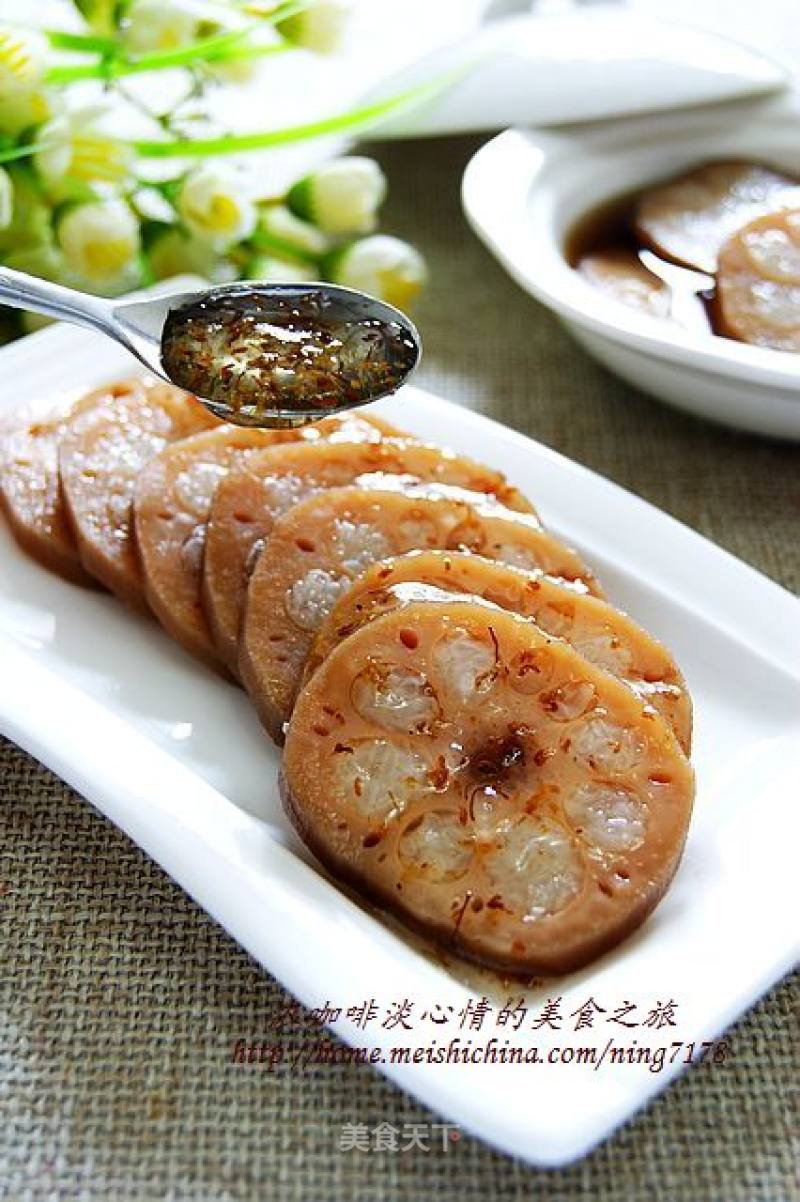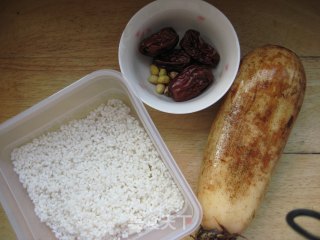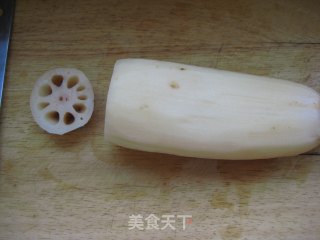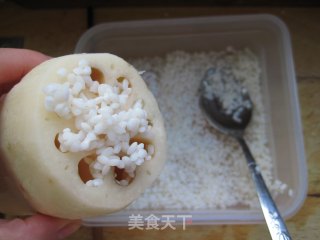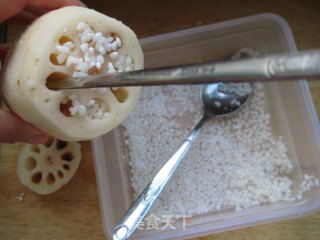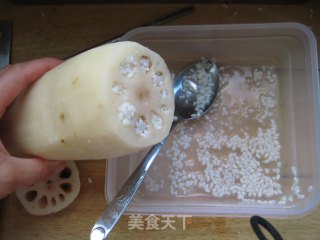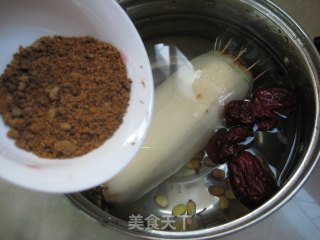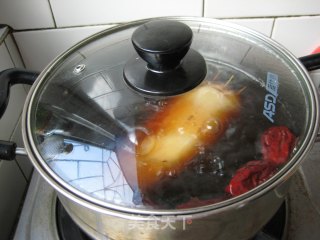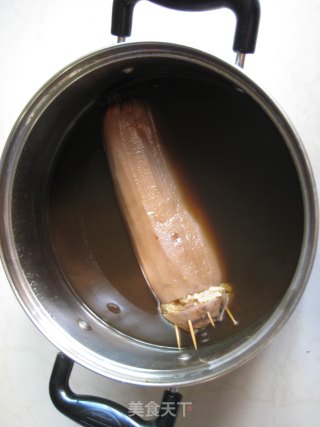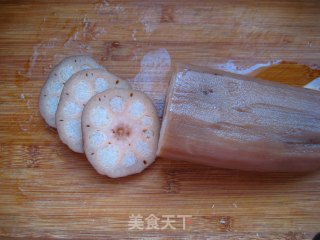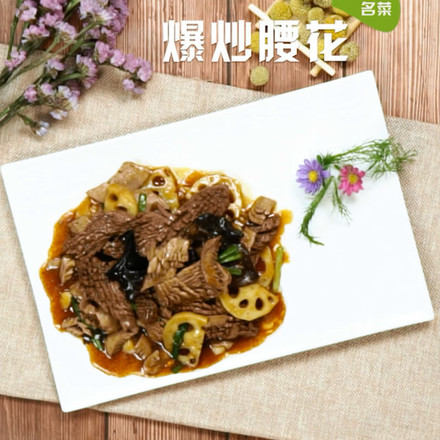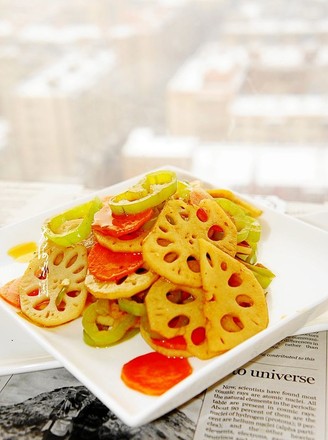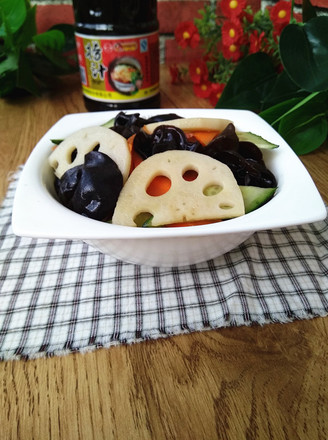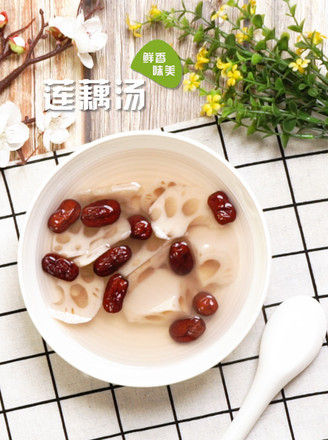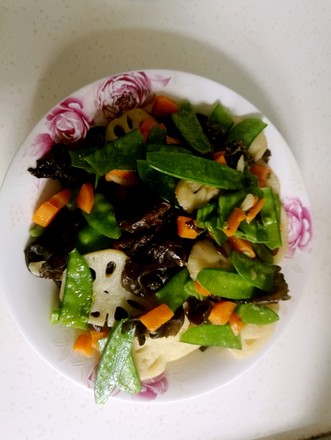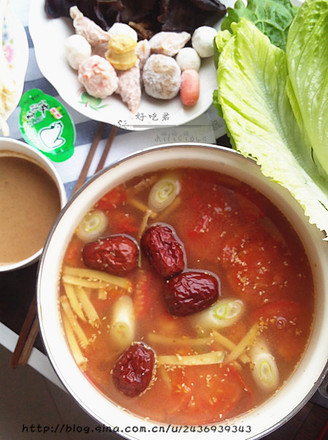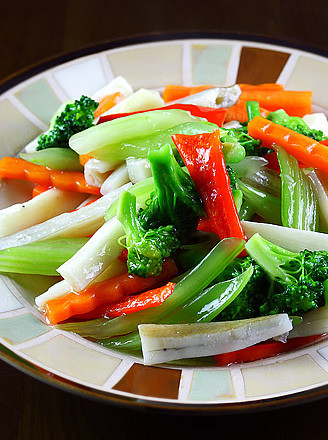Osmanthus Lotus Rice
by Espresso light mood
Favorite
Difficulty
Easy
Time
2h
Serving
2
Osmanthus glutinous rice lotus root is also known as honey glutinous rice lotus root. The glutinous rice is poured into lotus root and is carefully made with sweet-scented osmanthus sauce and red dates. It is a unique Chinese dessert in Jiangnan traditional dishes. It is sweet, crisp and rich in sweet-scented osmanthus aroma. And enjoy the reputation. Hangzhou sweet-scented osmanthus glutinous rice lotus root is soft and sweet, and the lotus root of West Lake is the best among lotus roots. The same famous Nanjing sweet-scented osmanthus honey juice lotus root is also known as Jinling along with "osmanthus sweet-scented taro seedlings, plum cakes, red bean wine stuffed balls" The four most humane street snacks in Nanjing.
There is a record in the "Shen Nong's Materia Medica": lotus root "nourishes the mind, nourishes the spirit, eliminates all diseases, long-term service, light body and endurance." Traditional Chinese medicine believes that lotus root is cold and sweet, and enters the heart, liver, spleen and stomach. Classics are divided into raw and cooked, and the properties of raw and cooked medicines are different. Raw lotus root is cold, sweet and cold enters the stomach, can produce body fluid to quench thirst, dispel blood stasis and clear heat, cool blood, and stop vomiting. The role of. Therefore, eating cooked lotus root is beneficial to the elderly, especially those with weak spleen and stomach. Because the lotus root joints between the lotus roots contain about 2% of tannin and asparagine, its hemostatic and astringent effect is stronger than that of fresh lotus roots, and it can also detoxify crabs.
Lotus root: Among tuber foods, lotus root contains higher iron content, so it is quite suitable for patients with iron deficiency anemia. The sugar content of lotus root is not very high, but it also contains a lot of vitamin C and dietary fiber. It is very beneficial to people with debilitating diseases such as liver disease, constipation, and diabetes. It is rich in trace elements such as iron and calcium. It is also rich in plant protein, vitamins and starch, which can obviously replenish qi and blood and enhance human immunity. Lotus root is also rich in vitamin K, which has the effect of constricting blood vessels and blood. It is very suitable for people with congestion, vomiting blood, hematuria, hematuria, blood in the stool and women who are pregnant. Lotus root can also dissipate heat and is a good heat-relieving food.
Glutinous rice: Glutinous rice contains protein, fat, carbohydrates, calcium, phosphorus, iron, vitamin B1, vitamin B2, niacin and starch, etc. It is rich in nutrients and is a warming and strengthening food; it can nourish the middle and nourish qi, invigorate the spleen and stomach , It has the effect of relieving deficiency and sweating, and has a certain alleviating effect on the deficiency and cold of the spleen and stomach, poor appetite, abdominal distension and diarrhea; glutinous rice has astringent effect, and has a good therapeutic effect on frequent urination and night sweats.
Osmanthus: Chinese medicine believes that osmanthus has good medicinal value. The ancients said that osmanthus is the longevity of a hundred medicines, so the wine brewed with osmanthus can achieve the effect of "drinking a thousand years of life". Osmanthus fragrans is warm in nature and pungent in taste. It enters the lungs, large intestine meridian, and is taken orally by decoction, tea or wine soaking. It has the effects of warming the middle and dispelling cold, warming the stomach and relieving pain, resolving phlegm and dispersing stasis, and treating loss of appetite, phlegm, cough, wheezing, and hemorrhoids , Dysentery, amenorrhea and abdominal pain have a certain effect. Black tea is warm in nature, has the functions of warming the spleen and stomach, helping digestion, and can promote appetite; brown sugar has the effects of nourishing qi and blood, invigorating the spleen and stomach, expelling wind and cold, and invigorating blood circulation. It is especially suitable for pregnant women, children and people with anemia. . Therefore, people with deficiency of the spleen and stomach and weak spleen and stomach function can drink osmanthus tea to warm the stomach. However, people with symptoms such as burning and pain in the stomach, dry mouth, hunger but not wanting to eat, yellow urine, sticky stool and other symptoms are not suitable for drinking. "
There is a record in the "Shen Nong's Materia Medica": lotus root "nourishes the mind, nourishes the spirit, eliminates all diseases, long-term service, light body and endurance." Traditional Chinese medicine believes that lotus root is cold and sweet, and enters the heart, liver, spleen and stomach. Classics are divided into raw and cooked, and the properties of raw and cooked medicines are different. Raw lotus root is cold, sweet and cold enters the stomach, can produce body fluid to quench thirst, dispel blood stasis and clear heat, cool blood, and stop vomiting. The role of. Therefore, eating cooked lotus root is beneficial to the elderly, especially those with weak spleen and stomach. Because the lotus root joints between the lotus roots contain about 2% of tannin and asparagine, its hemostatic and astringent effect is stronger than that of fresh lotus roots, and it can also detoxify crabs.
Lotus root: Among tuber foods, lotus root contains higher iron content, so it is quite suitable for patients with iron deficiency anemia. The sugar content of lotus root is not very high, but it also contains a lot of vitamin C and dietary fiber. It is very beneficial to people with debilitating diseases such as liver disease, constipation, and diabetes. It is rich in trace elements such as iron and calcium. It is also rich in plant protein, vitamins and starch, which can obviously replenish qi and blood and enhance human immunity. Lotus root is also rich in vitamin K, which has the effect of constricting blood vessels and blood. It is very suitable for people with congestion, vomiting blood, hematuria, hematuria, blood in the stool and women who are pregnant. Lotus root can also dissipate heat and is a good heat-relieving food.
Glutinous rice: Glutinous rice contains protein, fat, carbohydrates, calcium, phosphorus, iron, vitamin B1, vitamin B2, niacin and starch, etc. It is rich in nutrients and is a warming and strengthening food; it can nourish the middle and nourish qi, invigorate the spleen and stomach , It has the effect of relieving deficiency and sweating, and has a certain alleviating effect on the deficiency and cold of the spleen and stomach, poor appetite, abdominal distension and diarrhea; glutinous rice has astringent effect, and has a good therapeutic effect on frequent urination and night sweats.
Osmanthus: Chinese medicine believes that osmanthus has good medicinal value. The ancients said that osmanthus is the longevity of a hundred medicines, so the wine brewed with osmanthus can achieve the effect of "drinking a thousand years of life". Osmanthus fragrans is warm in nature and pungent in taste. It enters the lungs, large intestine meridian, and is taken orally by decoction, tea or wine soaking. It has the effects of warming the middle and dispelling cold, warming the stomach and relieving pain, resolving phlegm and dispersing stasis, and treating loss of appetite, phlegm, cough, wheezing, and hemorrhoids , Dysentery, amenorrhea and abdominal pain have a certain effect. Black tea is warm in nature, has the functions of warming the spleen and stomach, helping digestion, and can promote appetite; brown sugar has the effects of nourishing qi and blood, invigorating the spleen and stomach, expelling wind and cold, and invigorating blood circulation. It is especially suitable for pregnant women, children and people with anemia. . Therefore, people with deficiency of the spleen and stomach and weak spleen and stomach function can drink osmanthus tea to warm the stomach. However, people with symptoms such as burning and pain in the stomach, dry mouth, hunger but not wanting to eat, yellow urine, sticky stool and other symptoms are not suitable for drinking. "

